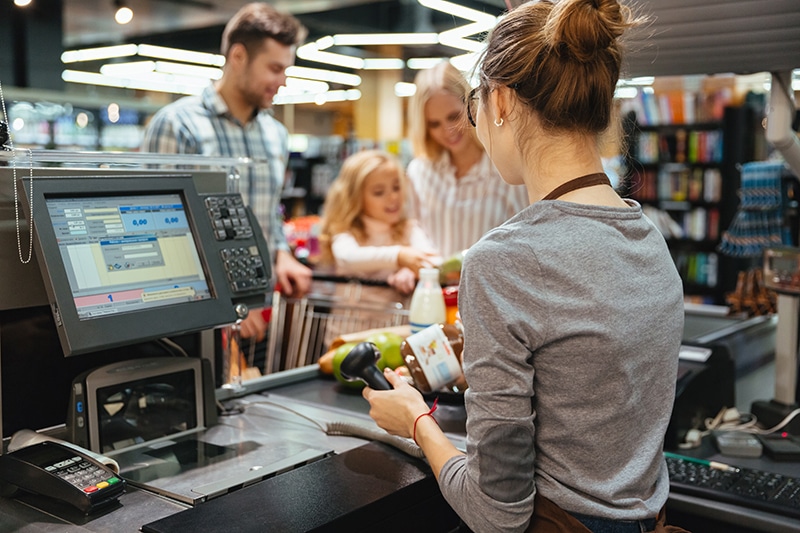New technology trends have disrupted the retail sector as well, and shopping has become more internet-driven as retailers have changed various processes for dealing with the supply chain. When discussing the impact of technology on the shopping and retail sector, E-commerce is often what retailers think of first. In fact, innovative technologies such as AI, computer vision and IoT have completely revolutionized the shopping experience (from browsing to checkout) and the way organizations run stores and customers shop. According to a report from Gartner, more than 77 percent of retailers want to use Artificial intelligence (AI) in the future. Several novel technology trends in the business approach have made retailers handle many responsibilities and rely on back office outsourcing solutions to perform these tasks in a cost-effective manner.
Evolution of a Typical Shopper in Retail Business
Before discussing the technology trends that have driven innovation in the retail sector, it is important to understand how typical shoppers have evolved over the past decade. In fact, the rise of e-commerce has highlighted the extent to which customers tend to value convenience and choice. Despite this trend, physical retail has developed its share of e-commerce sales in the retail space. This has encouraged physical retailers to adopt new technology at a much faster pace. In the present times, customer experience matters above other things in retail. In fact, retail brands that provide positive customer experiences have been shown to make three times as much as companies that fail to do the same. In a bid to provide these experiences, retailers have started adopting a wide variety of innovative solutions.
Top 8 Technology Trends
Here discussed are some of the top technology trends that could rule the retail industry in 2022 –
- Artificial Intelligence (AI) – The retail industry is becoming more data-driven and data-centric. The huge data or information can be effectively used for conducting predictive analytics. Data in the retail involves different types like – data related to retail pricing strategies, competitive intelligence, social media metrics, and seasonality. However, the complexity of this data has resulted in a great deal of inefficiencies from errors. AI can be used in inventory management and analyzing the different patterns of consumer behavior as this will help boost conversion rate and increase sales.
- Inventory management – Artificial intelligence can help manage these inventories more effectively with a number of different methods. For instance, AI can measure consumer spending analytics to predict when certain types of items are more likely to move around on the sales floor. This can drive the system to require manual auditing of certain areas over others. While auditing the entire store can be complex, auditing only the areas that need attention is much more effective. For example, Amazon takes it a step further with its Amazon Go Grocery model stores powered by Just Walk Out. The project uses computer vision, sensor fusion, and deep learning IoT sensor technologies to detect when a consumer has taken an item off the shelf and placed it into their cart. When the guest leaves the store, their credit card is charged for the items that they took. This requires not only a deep understanding of what the guest has placed into their cart but also where items are in the store.
- Consumer behavior analysis – AI can help analyze patterns in consumer behavior. AI technology can be used to measure not only the spending habits of consumers but also in what ways they’re spending money on, alongside their demographics. This can give businesses a better idea of how they should be marketing to their specific group of audiences. AI can be used to track a user’s behavior when they visit an online storefront. Key information like what items their cursor hovers over, how much time they spend on a particular page, as well as where they come from – can be analyzed.
- AR in Chatbots – Augmented reality (AR) shopping experience is becoming a new norm in 2022. With several advanced technology features like – virtual fitting rooms, enhanced in-store AR navigation and others spreading across the market, those without these features are falling behind. In fact, these technological advancements are bridging the gap between digital ecommerce storefronts and brick and mortar shopping. AR will help use real-time information in the form of audio, graphics, text, and other mediums. Several retail companies are combining AR with chatbots to provide a huge and feature-rich shopping experience to customers by engaging with them in all dimensions. Chatbots will empower customers to virtually try out new items and they don’t need to visit the physical store for getting that feel. Augmented reality-based indoor navigation technology can help shoppers locate the items that they require in store just by following directions on their phone’s screen. This can be very engaging for shoppers and if implemented correctly, can offer more opportunities to show guests targeted suggestions on-screen.
-
- Click and Collect – Buy online pick up in-store (BOPIS) has emerged as a new retail technology trend during the COVID-19 pandemic. With so many new ways to order goods, point of sale systems need to be updated in an intelligent manner. Retail stores were utilizing this technology during the pandemic for selling without worrying about the costs of expanding their delivery network. As social distancing restrictions are still applicable in some areas, only a limited number of people are allowed in the stores. Not all businesses were able to survive the shift in emphasis to digital retail options. In fact, Microsoft’s physical stores were shut down around the country. However, those who were able to adapt to these changes include – Walmart and Target. Customers have adopted Click and collect for shopping as it eliminates the shipping time.
Reports from Black Friday suggest that, more than 50 percent of shoppers are planning to increase click and collect in 2022 – which is going to be the biggest retail IT trend in 2022. Instead of having too many systems in place to handle both online and in-store purchases, the key to utilizing this technology is to have a unified and connected system that can integrate other order management tools and use data analytics to provide a smooth shopping experience. Customers can easily order whatever they want from the store.
-
- Voice Assistants – As per reports, the voice shopping market is likely to grow to $40 billion in the United States alone by 2022. Smart assistants like Google Assistant, Microsoft Cortana, Alexa, Siri, and Bixby are becoming more and more advanced in their voice recognition and responsiveness.
In fact, customers are using voice assistants for exploring, finding and ordering products from home with their voice with or without a screen to aid visually. They can do comparison shopping by using their voice. Smart home devices are expected to be used in more than 77 million homes in the United States by 2025, meaning there is a huge opportunity that businesses can take advantage of. Several other kinds of IoT devices in customers’ homes such as AR-capable smart mirrors can prove valuable too. For instance, Walmart’s Voice Ordering is a great example of this technology in action. This technology involves asking smart speakers to add products to a cart, meaning orders can be easily and entirely placed by voice. Those items can then be made available for pickup by Walmart’s workers.
- Security – Advanced technologies have helped retailers improve efficiency and survive during the pandemic. However, there is still a concern about data applications and security. It is important for retailers to protect data from complex cyber-attacks. A good security strategy will help protect data and applications from attackers. By incorporating advanced technology, retailers focus on building cyber defence capabilities. This will help in infusing agility, securing brand trust, and building business resiliency. When creating a threat protection plan, it is important to consider systems, applications, partners, and employees as this will help protect important data from attackers.
- Visual Search – Regarded as one of the most popular retail trends, visual search will provide a frictionless journey to customers. According to research from Gartner, visual search can increase retail sales by 30 percent. Image-based visual search can help customers to easily find products. Customers don’t need to use keywords for finding products on e-commerce sites. Rather, visual search will use real-world images for product discovery and online search. Customers can upload an image of the product that they wish to buy. The visual search engine will help in finding the visually closest product. It will check online catalogue and provide the search result to the customer. In addition, it can also make related product suggestions to customers.
- Payment Flexibility – Customers always choose to make online payments. Online money platforms like Venmo, Apple Pay, and PayPal are helping customers in doing online payments. They can also use crypto accounts for paying online. In addition, most retail companies are offering payment time flexibility to customers. Retailers are accepting “buy-now-pay-later” or BNPL options. There are payment installments like ZipPay, Klarna, and Afterpay that will allow retailers to get all the payments upfront. Customers will be paying installments to the payment apps. Retail store owners don’t need to worry about these installments. Customers can also buy whatever they want to buy. In short, this is a win-win for everyone.
- One-to-one Personalization – With connected technologies and omnichannel retail affecting the line between online and physical shopping, retailers can personalize their offerings more than ever before. An Infosys study revealed that 59 percent of shoppers who experienced personalization in retail believe that it influenced their purchasing decisions. AI, computer vision technologies help retailers to know what products to offer, where to offer and when to offer. Customers can receive personalized promotions and recommendations based on past purchases. This technology can also be used to provide customers with personalized discounts while they are shopping in-store, using screens or push notifications to share discounts that are more likely to encourage a purchase decision. In addition, the modern shopper expects options like contactless checkout and self-checkout to be available to them at all times. This offers customers (who shopped during the pandemic) the convenience and variety that multiple checkout options can give them.
As technological advancements evolve in the retail industry, legacy technologies like older PoS systems, inventory management solutions etc. are being replaced. Retailers are embracing technologies like AI, Robotic Process Automation, Chatbots, and advanced analytics. Each of these technological innovations has radically changed the way customers interact with retail brands and the way retailers run their businesses.
With customers continuing to shop across a variety of channels and platforms, these technologies will only grow in scope and capability. This allows organizations to focus on their core competencies and deliver customer-centered experiences. The support of reliable business process outsourcing companies can ensure efficient process management, and cost reduction. They can gain a competitive advantage and improve their connection with shoppers.




